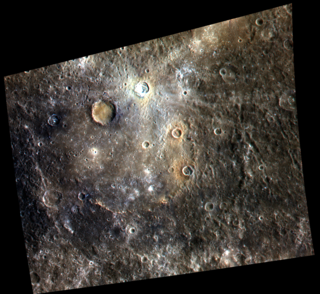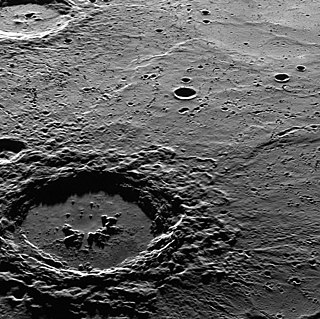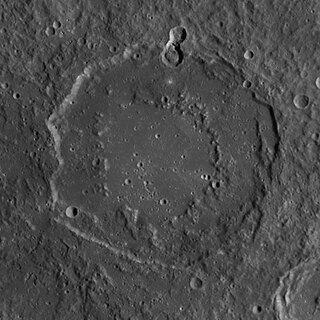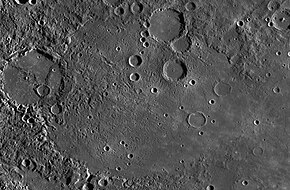
Degas is a rayed crater on Mercury at latitude 37.5 N, longitude 127 W. Its diameter is 54 kilometres (34 mi). It was named after the French impressionist painter Edgar Degas in 1979. The rays consist of light colored material blasted out during the crater's formation. Craters older than Degas are covered by the ray material, while younger craters are seen superimposed on the rays. Degas forms a crater pair with Brontë to the north. Both lie near the center of Sobkou Planitia.

Rodin is an impact crater on the planet Mercury, 230 kilometers in diameter. The rim is even and circular, except where it is broken in two places toward the north and south. It is named for the French sculptor Auguste Rodin. Its name was approved by the International Astronomical Union in 1976.

Homer is a crater on Mercury. It is one of 110 peak ring basins on Mercury. It is Tolstojan in age.

Hokusai is a rayed impact crater on Mercury, which was discovered in 1991 by ground-based radar observations conducted at Goldstone Observatory. The crater was initially known as feature B. Its appearance was so dissimilar to other impact craters that it was once thought to be a shield volcano. However, improved radar images by the Arecibo Observatory obtained later in 2000–2005 clearly showed that feature B is an impact crater with an extensive ray system. The bright appearance of rays in the radio images indicates that the crater is geologically young; fresh impact ejecta has a rough surface, which leads to strong scattering of radio waves.

Derain is a crater on Mercury named after André Derain, a French artist, painter, sculptor and co-founder of Fauvism with Henri Matisse. It has uncommonly dark material within and surrounding the crater. The material is darker than the neighboring terrain such that this crater is easily identified even in a distant global image of Mercury. The dark halo may be material with a mineralogical composition different from the majority of Mercury's visible surface. Craters with similar dark material on or near their rims were seen on the floor of the Caloris basin during MESSENGER’s first flyby.

Ahmad Baba is a crater on Mercury. It has a diameter of 127 kilometers. Its name was adopted by the International Astronomical Union (IAU) in 1979.

Ailey is a crater on Mercury. It has a diameter of 21 kilometers. Its name was adopted by the International Astronomical Union (IAU) in on April 24, 2012. Ailey is named for the American dancer and choreographer Alvin Ailey, who lived from 1931 to 1989.

Aksakov is a crater on Mercury. It has a diameter of 174 kilometers. Its name was adopted by the International Astronomical Union (IAU) on April 24, 2012. Aksakov is named for the Russian author Sergey Aksakov, who lived from 1791 to 1859 C.E.

Bernini is a crater on Mercury. It has a diameter of 146 kilometers. Its name was adopted by the International Astronomical Union (IAU) in 1976. Bernini is named for the Italian architect and sculptor Gian Lorenzo Bernini, who lived from 1598 to 1680.

Darío is a crater on Mercury. It has a diameter of 151 kilometers. Its name was adopted by the International Astronomical Union (IAU) in 1976. Dario is named for the Nicaraguan poet Rubén Darío, who lived from 1867 to 1916.

Dostoevskij is a crater on Mercury. It has a diameter of 430 kilometers. Its name was adopted by the International Astronomical Union in 1979. Dostoevskij is named for the Russian novelist Fyodor Dostoyevsky, who lived from 1821 to 1881. It is Tolstojan in age.

Dürer is a crater on Mercury. It has a diameter of 195 kilometers. Its name was adopted by the International Astronomical Union (IAU) in 1976. Durer is named for the German artist Albrecht Dürer, who lived from 1471 to 1528.

Futabatei is a crater on Mercury. It has a diameter of 57 kilometers. Its name was adopted by the International Astronomical Union in 1976. Futabatei is named for the Japanese novelist Futabatei Shimei, who lived from 1864 to 1909.

Handel is a crater on Mercury. It has a diameter of 166 kilometers. Its name was adopted by the International Astronomical Union in 1976. Handel is named for the British-German composer George Frideric Handel, who lived from 1685 to 1759.

Mark Twain is a crater on Mercury. Its name was adopted by the International Astronomical Union (IAU) in 1976. Mark Twain is named for the American author Mark Twain, who lived from 1835 to 1910.

Holst is a crater on Mercury. Its name was adopted by the International Astronomical Union (IAU) on April 24, 2012.

Caravaggio is a large crater on Mercury. The crater was named after the Italian painter Caravaggio by the IAU in 2013.

Sanai is a large, ancient crater on Mercury. Its name was adopted by the International Astronomical Union in 2014, after the Persian poet, Sanai of Ghazna.

Alver is a crater on Mercury. It has a diameter of 151.49 kilometers. Its name was adopted by the International Astronomical Union (IAU) on March 15, 2013. Alver is named for the Estonian poet Betti Alver.

Nabokov is a crater on Mercury. Its name was adopted by the International Astronomical Union (IAU) on April 24, 2012. Nabokov is named for the Russian and American author Vladimir Nabokov.





















